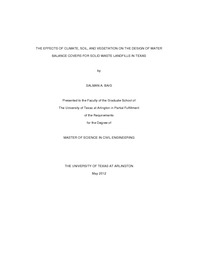
ATTENTION: The works hosted here are being migrated to a new repository that will consolidate resources, improve discoverability, and better show UTA's research impact on the global community. We will update authors as the migration progresses. Please see MavMatrix for more information.
Show simple item record
| dc.contributor.author | Baig, Salman | en_US |
| dc.date.accessioned | 2012-07-25T19:10:20Z | |
| dc.date.available | 2012-07-25T19:10:20Z | |
| dc.date.issued | 2012-07-25 | |
| dc.date.submitted | January 2012 | en_US |
| dc.identifier.other | DISS-11663 | en_US |
| dc.identifier.uri | http://hdl.handle.net/10106/11120 | |
| dc.description.abstract | The purpose of this study is to determine the effects of climate, soil, and vegetation on the design of water balance (WB) covers for solid waste landfills in Texas. This study was conducted using water balance software (UNSAT-H model) that considers unsaturated soil hydraulics and plant water uptake. To date, limited research has been conducted for WB covers in Texas. Texas is located in the central region of the United States and encounters approximately nine distinct 5 inch precipitation increments or ranges, unlike any other state in the United States. Texas includes various climate regions and is a favorable choice among other states to determine the effects of climate on the design of WB covers.Approximately 190 solid waste landfills in Texas accepted waste in Fiscal Year 2010 based on information from the Texas Commission on Environmental Quality (TCEQ). This study analyzes the design for WB covers for four regions that serve approximately 70 landfills or 37% of the landfills in Texas. The regions were selected based on different climatic conditions: arid, semi-arid, sub-humid, or humid climate.The soils analyzed in this study include clay, silt, clayey sand, and sand, which are usually found during landfill excavation and can potentially be used for WB covers. The clay, silt, and clayey sand soils contain fine-grained particles that provide water storage capacity for WB covers; WB covers rely on: 1) water storage during periods of increased precipitation, and 2) evaporation from surface soils and transpiration through vegetation from deeper soils during drier periods. The design of capillary barriers (sandy soil placed under fine-grained soils to provide capillary break and maximize storage in overlying fine-grained soil) is also analyzed in this study. The vegetation properties analyzed in this study include non-vegetated conditions and vegetated conditions with root depths up to 36 inches. The maximum allowable percolation rate is 4 mm/year in Texas (TCEQ) at the base of the WB cover for determining equivalency to the conventional cover and preventing additional leachate generation, as discussed in this study. An iterative process was used to determine the required design thickness that met the 4 mm/year percolation design standard for all conditions analyzed. The required design thickness is determined from three factors: climate, soil type, and vegetation. The results of this study indicate that more humid climates with greater precipitation require a larger design thickness. Also, the hydraulic conductivity of soil is the most important factor in WB cover design; the CL soil cover required the least design thickness because of its lowest hydraulic conductivity. Vegetated conditions provide for a decrease in required thickness compared to non-vegetated conditions, and the required thickness decreases as deeper roots are modeled. | en_US |
| dc.description.sponsorship | Hossain, Sahadat | en_US |
| dc.language.iso | en | en_US |
| dc.publisher | Civil & Environmental Engineering | en_US |
| dc.title | The Effects Of Climate, Soil, And Vegetation On The Design Of Water Balance Covers For Solid Waste Landfills In Texas | en_US |
| dc.type | M.S. | en_US |
| dc.contributor.committeeChair | Hossain, Sahadat | en_US |
| dc.degree.department | Civil & Environmental Engineering | en_US |
| dc.degree.discipline | Civil & Environmental Engineering | en_US |
| dc.degree.grantor | University of Texas at Arlington | en_US |
| dc.degree.level | masters | en_US |
| dc.degree.name | M.S. | en_US |
Files in this item
- Name:
- Baig_uta_2502M_11663.pdf
- Size:
- 5.298Mb
- Format:
- PDF
This item appears in the following Collection(s)
Show simple item record


